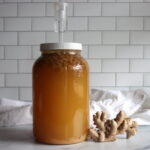Ginger Wine (& Mead)
Ginger wine is a lovely warming drink, perfect for sipping on cold, dark evenings.
Servings: 20 glasses, Makes 1 Gallon (about 4 bottles)
Equipment
- Air Lock & Stopper
Ingredients
- 2 oz ginger root
- 2 pounds Sugar about 4 cups
- 7-½ pints white grape juice unsweetened
- 1 cup golden raisins
- 1 tsp yeast nutrient
- ½ tsp acid blend
- ¼ tsp tannin powder
- 1 packet wine yeast see note
- Optional ~ Campden Tablet and Potassium Sorbate for Stabilizing I do not use these
Instructions
- Chop golden raisins and shred ginger root. Add to primary fermentation vessel.
- Mix the white grape juice and sugar, stirring until dissolved.
- Add to carboy.
- Add the acid blend, wine tannin and yeast nutrient. Stir to incorporate.
- Rehydrate yeast for 10 minutes in a small amount of room temperature water. Add to the carboy and seal with a water lock
- Ferment in primary for 1 to 2 weeks, until the active fermentation begins to die out.
- Siphon to a clean vessel for secondary, straining out raisins and ginger root.
- Top with more water as needed to bring the level up to the neck of the carboy and seal with the water lock.
- Ferment 30 days.
- Rack to a clean container, top up with water and refit the water lock. Ferment 2 months.
- Sample the wine and backsweeten as needed. See notes for information on backsweetening.
- Bottle the wine and seal with wine corks. This wine can be enjoyed right away, but is best bottle-aged for 6 months.
Notes
Ginger Mead
To make a one-gallon batch of ginger mead, substitute 2 lbs honey for the 2 lbs of sugar. You can also skip the white grape juice for mead as the honey should have enough body on its own. If you do skip the grape juice, go with 3 pounds honey. Time spent in secondary will be longer than for wine — anywhere between 2 to 6 months.Yeast
For ginger wine, champagne yeast is preferred. A few good yeast choices include Red Star Premier Blanc, Red Star Premier Cuvee, Lalvin EC-1118 and Lalvin K1-V1116. See notes within the article for the specific qualities of each yeast.Stabilizing and Back Sweetening
This wine will be quite dry at the end of secondary, so backsweetening may be needed. To backsweeten, first rack to a clean container and stabilize your wine by adding 1 Campden tablet and ½ teaspoon potassium sorbate. (If you skip stabilizing, the added sugar can cause a rapid ferment and bottled wine may burst under the pressure.) Wait 24 hours after stabilizing, then add sugar to taste. This is done by making a simple syrup made by heating equal parts sugar and water. After sweetening, refit water lock and let the wine ferment for 10 days to ensure all yeast have died out, then bottle. See notes within the article for further information regarding stabilizing and back sweetening.Nutrition
Calories: 305kcal | Carbohydrates: 78g | Protein: 1g | Fat: 0.4g | Saturated Fat: 0.1g | Polyunsaturated Fat: 0.1g | Monounsaturated Fat: 0.01g | Sodium: 11mg | Potassium: 251mg | Fiber: 1g | Sugar: 75g | Vitamin A: 14IU | Vitamin C: 1mg | Calcium: 24mg | Iron: 1mg
